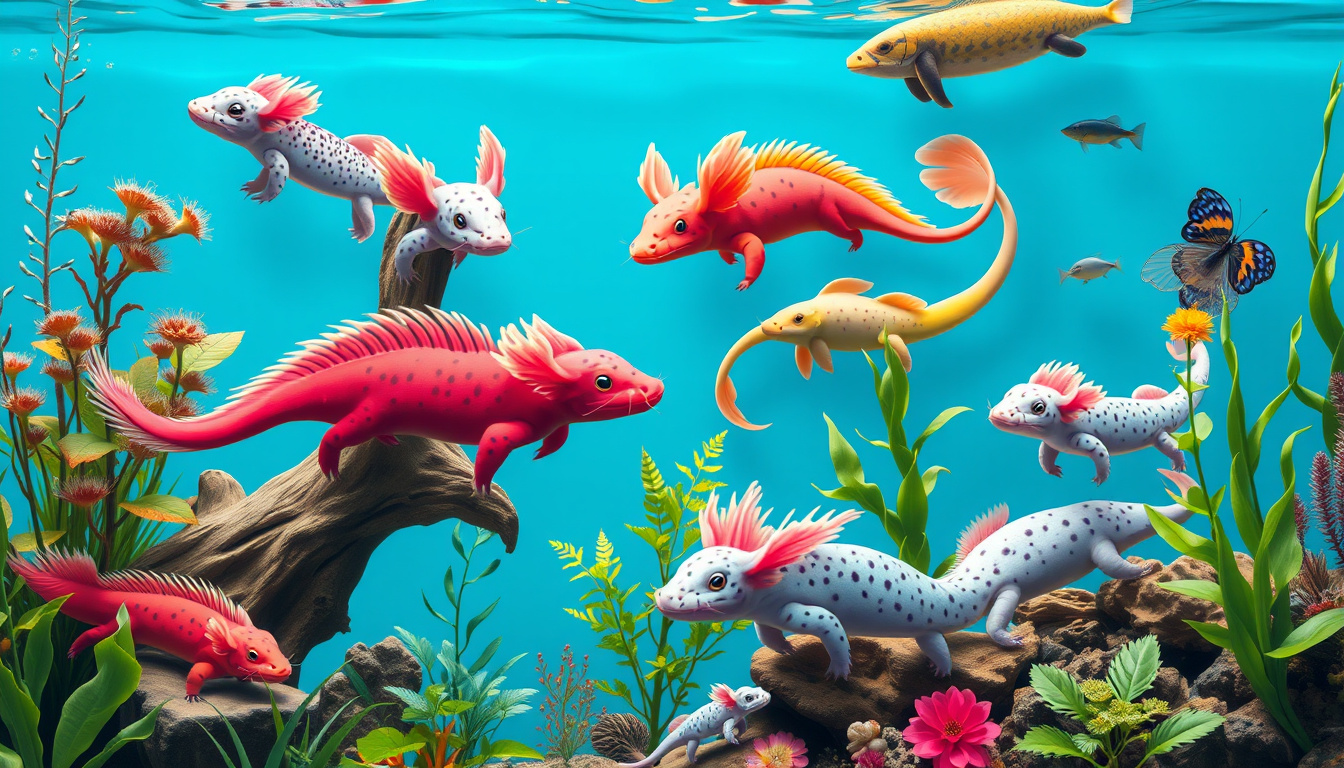Are you ready to dive into the colorful and captivating world of axolotls?
These incredible amphibians, with their unique traits and fascinating variations, have taken the internet by storm, captivating young audiences and animal lovers alike.
In this article, we’ll explore the diverse axolotl species variation that exists, uncover the unique characteristics that set them apart, delve into their habitats, and discuss the critical conservation efforts being made to protect these extraordinary creatures.
Whether you’re a budding biologist or simply curious about these enchanting beings, join us as we embark on a journey through the wonders of axolotl species!


Habitat and Distribution of Axolotl Species
When exploring the fascinating world of axolotl species variation, it’s essential to understand where these unique creatures are found and how their habitats shape their characteristics.
Native to the lake complex of Xochimilco in Mexico City, axolotls thrive in freshwater lakes with cold temperatures and abundant vegetation.
Unfortunately, due to habitat destruction and pollution, their natural distribution has shrunk dramatically.
The various axolotl species exhibit remarkable differences in color, size, and regenerative abilities, reflecting adaptations to their specific environments.
In captivity, axolotls are often bred to enhance these variations, including striking color morphs like leucistic and golden albino.
Nonetheless, conservation efforts are crucial to protect their natural habitats and ensure the survival of different axolotl species, allowing us to appreciate and study these extraordinary amphibians for years to come.
Conservation Efforts for Axolotl Species
When it comes to the fascinating world of axolotl species variation, conservation efforts play a crucial role.
These unique amphibians, often referred to as ‘Mexican walking fish,’ have captured the hearts of many due to their curious appearance and remarkable regenerative abilities.
However, the natural habitats of axolotls are rapidly declining, threatening their existence.
Organizations worldwide are stepping up, implementing breeding programs and habitat preservation initiatives to ensure the survival of these incredible creatures.
By raising awareness about axolotl species variation, from the wild-type to leucistic and golden morphs, conservationists hope to engage younger audiences in preserving the rich biodiversity of our planet.
Young people are key to driving the conservation message forward, encouraging responsible pet ownership and supporting research that aims to protect these iconic amphibians for future generations.
Frequently Asked Questions
What are the main types of axolotl species?
The main types of axolotl species include the wild-type axolotl, leucistic axolotl, golden albino axolotl, and piebald axolotl, each distinguished by their color, appearance, and other unique traits.
What unique traits do axolotl species have?
Unique traits of axolotl species can include variations in pigmentation, size, regenerative abilities, and physical characteristics such as gill structure and body shape.
Where do axolotls naturally inhabit?
Axolotls are primarily found in the lake complex of Xochimilco near Mexico City, in a habitat that includes canals and freshwater lakes with specific environmental conditions.
What conservation efforts are in place for axolotls?
Conservation efforts for axolotls include habitat restoration, breeding programs in captivity, and initiatives to raise awareness about the threats facing their natural habitats and populations.
What does the future hold for axolotl species variation?
The future of axolotl species variation depends on continued conservation efforts, research on their genetics, and addressing environmental threats that impact their habitats.
[center][/center]
[center][color=rgb(10, 10, 10)][highlight=rgb(255, 248, 231)] [/highlight][/color][color=rgb(10, 10, 10)][highlight=rgb(255, 248, 231)]As an Amazon Affiliate,[/highlight][/color][color=rgb(10, 10, 10)][highlight=rgb(255, 248, 231)] [/highlight][/color][color=rgb(10, 10, 10)][highlight=rgb(255, 248, 231)]Savvy Keto makes a commission[/highlight][/color][color=rgb(10, 10, 10)][highlight=rgb(255, 248, 231)] [/highlight][/color][color=rgb(10, 10, 10)][highlight=rgb(255, 248, 231)](at no extra cost to you)[/highlight][/color][color=rgb(10, 10, 10)][highlight=rgb(255, 248, 231)] [/highlight][/color][color=rgb(10, 10, 10)][highlight=rgb(255, 248, 231)]on purchases you make[/highlight][/color][color=rgb(10, 10, 10)][highlight=rgb(255, 248, 231)] [/highlight][/color][color=rgb(10, 10, 10)][highlight=rgb(255, 248, 231)]thru links on this site.[/highlight][/color][/center]

